Florida is the global epicenter for introduced nonnative reptiles and amphibians. These include well-known species such as Burmese pythons and green iguanas as well as dozens of other species of snakes, lizards, and frogs. There are four species of nonnative frogs currently established in Florida. The purpose of this publication is to summarize the status, biology, and impacts of one of those frogs, the Cuban treefrog. The publication also presents strategies to manage Cuban treefrogs to help alleviate human conflicts and benefit native species. The main target audience is homeowners who suspect they have Cuban treefrogs on their property and/or need technical assistance dealing with these often-problematic frogs. Environmental educators, natural resource managers, and professional scientists will also find the information herein of interest.
Introduction
The Cuban treefrog (Osteopilus septentrionalis, Figure 1) is native to Cuba, the Isle of Youth (an island province of Cuba also known as Isle of Pines), the Cayman Islands, and the Bahamas (Henderson and Powell 2009). Cuban treefrogs have been introduced inadvertently by people to many other islands in the Caribbean and the US mainland (Lever 2003). The earliest confirmed records in the United States date to the 1920s in the Florida Keys (Barbour 1931). The first Cuban treefrogs in Florida likely arrived as stowaways in shipping crates originating from the Caribbean. By the mid-1970s, they had dispersed throughout most of southern Florida. As of 2023, this introduced species was established throughout the Peninsula as well as in several areas of the Florida Panhandle (EDDMapS.org; S.A. Johnson, unpublished data; Figure 2). Additional breeding populations have been documented in Georgia and Louisiana (Glorioso et al. 2018; Jarboe et al. 2019). Isolated records of single Cuban treefrogs have been reported by citizen scientists from 29 additional states and several Canadian provinces (S.A. Johnson, unpublished data). Scientific research predicts that much of the southeastern United States will be suitable for Cuban treefrogs as the climate warms (Rodder and Weinsheimer 2009). Cuban treefrogs spread by hitchhiking on ornamental plants, motorized vehicles, boats, etc. The Cuban treefrog is considered an invasive species in Florida and elsewhere in the United States. An invasive species is defined as an organism that is not native to a specific geographic area where it was introduced by people and harms or can harm the environment, the economy or human quality of life (Iannone et al. 2020).

Credit: Steve A. Johnson, UF/IFAS
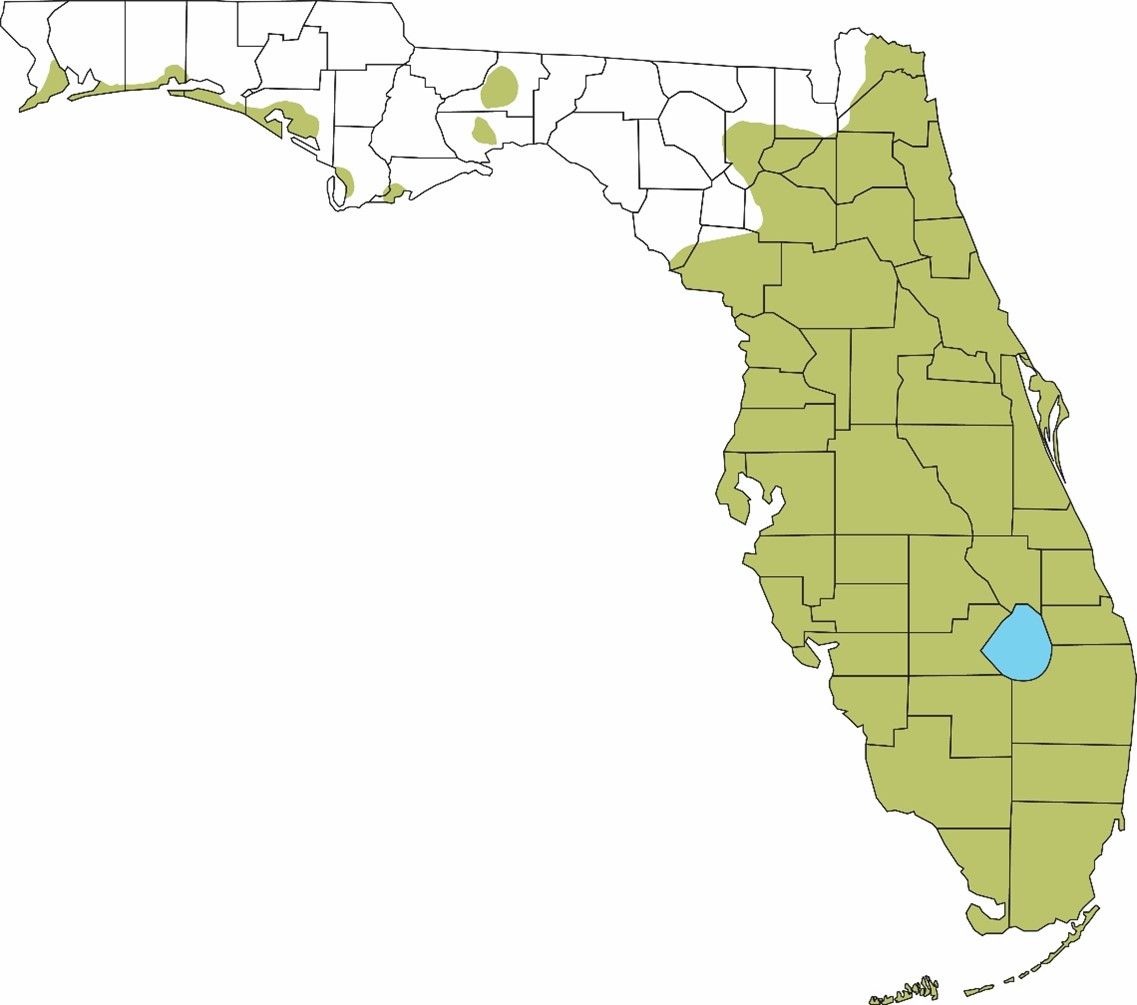
Credit: Tracy Bryant, UF/IFAS
Identifying Cuban Treefrog Adults, Juveniles, Tadpoles, and Eggs
All of Florida's treefrogs, including Cuban treefrogs, have expanded pads on the ends of their toes that allow them to climb trees, shrubs, windows, and buildings. Their round toepads help distinguish treefrogs from other frogs such as toads and aquatic frogs like bullfrogs. Cuban treefrogs have exceptionally large toepads as compared to Florida's native treefrogs (Figure 3).
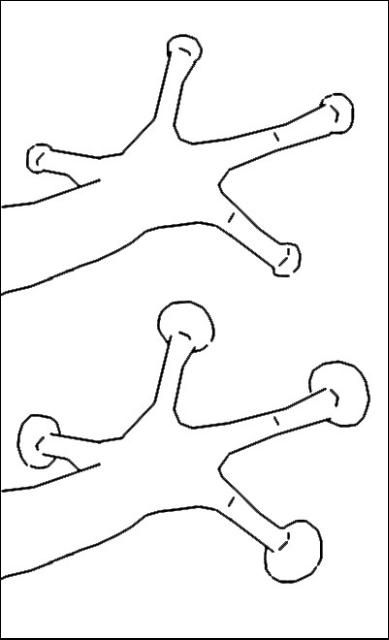
Credit: Monica McGarrity, UF/IFAS
As described below in more detail, the notable identifying features of Cuban treefrogs include:
- Large body size—any treefrog in Florida longer than 3 inches is almost certainly a Cuban treefrog
- Obvious “bug-eyes”
- Prominent warts of varying sizes on the back
- No warts on the top of the head
- Variable color, but usually white to light brown
- Yellow wash of color often visible in groin and armpits
- May have wavy darker markings on back
- Stripes/bands on rear legs
- Skin firmly fused to skull when larger than 1 inch long
Cuban treefrogs are the largest species of treefrog in Florida, and adult females may exceed 6 inches in body length (Krysko, Enge, and Moler 2019). Females grow considerably larger than males because a large body size is needed to hold the many eggs that females lay (McGarrity and Johnson 2009). Most Cuban treefrogs, however, range from 1.5–2.5 inches long (not including outstretched legs). They have very large eyes, giving them a somewhat "bug-eyed" appearance. Adults almost always have warty skin with prominent warts of varying sizes spread randomly on their back. Sometimes warts are visible on the upper surface of their legs. They do not have warts on the top of their head, however. They often have a yellowish wash where their front and rear legs are attached to their body, but the legs need to be stretched out a bit for the yellow to be visible. The colors of Cuban treefrogs vary a lot. Most often they are creamy white to light brown, although they can be green, gray, beige, yellow (breeding males), dark brown, or a combination of these colors (Figure 4). The patterns of markings on Cuban treefrogs are also variable. They may be a solid color without any pattern, but many have a pattern of large wavy markings or blotches on their back.They frequently have stripes or bands on the dorsal surface of their legs. Once Cuban treefrogs reach a body length of approximately 1 inch, the skin on top of their head becomes tightly fused to the skull.
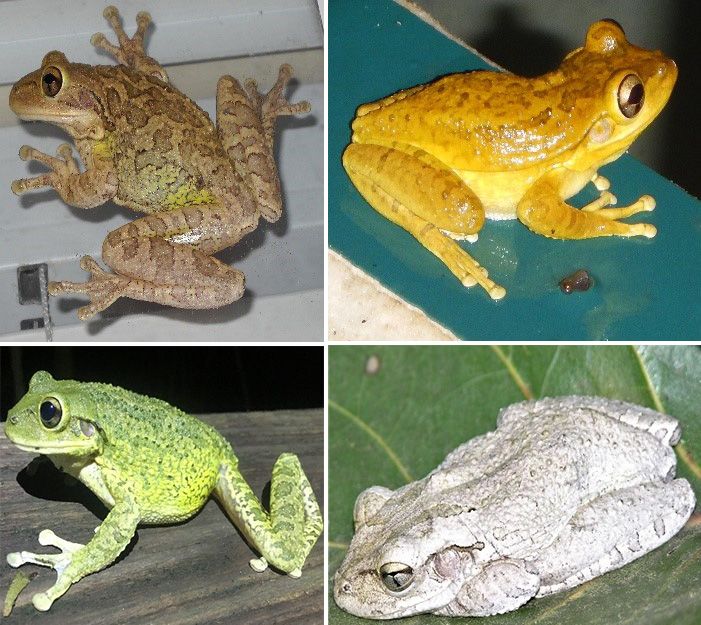
Credit: First image by Ted Orht; all others by Steve A. Johnson, UF/IFAS
Several of Florida's native treefrogs can resemble Cuban treefrogs as adults. These frogs, like Cuban treefrogs, also show considerable variation in colors and markings but generally are smaller and have smaller eyes and toepads. Still, it can be difficult to distinguish some native treefrogs from invasive Cuban treefrogs. The native species most likely to be confused with Cuban treefrogs are the barking treefrog and Cope’s gray treefrog. When managing Cuban treefrogs by capturing and humanely euthanizing them (see below), it’s important to be able to confidently distinguish them from native frogs. For identification tips and images of Florida's treefrogs, and to learn how to differentiate them, please visit the UF/IFAS Wildlife website at http://ufwildlife.ifas.ufl.edu and follow the "Florida Frogs" link in the left-hand column.
Young Cuban treefrogs that have recently metamorphosed from a tadpole into a small frog look different than the adults and are easy to identify. The most obvious feature is a light-colored, jagged line that runs from eye (not the lip) to the rear legs. The color of little Cuban treefrogs varies from gray to brown to green. The eyes are usually reddish brown and small warts are often visible on their back (Figure 5). The bluish leg bones of juvenile Cuban treefrogs are visible through their translucent leg muscles. To best see this feature, the frog should be held up to a light or placed on a white background (Figure 6).
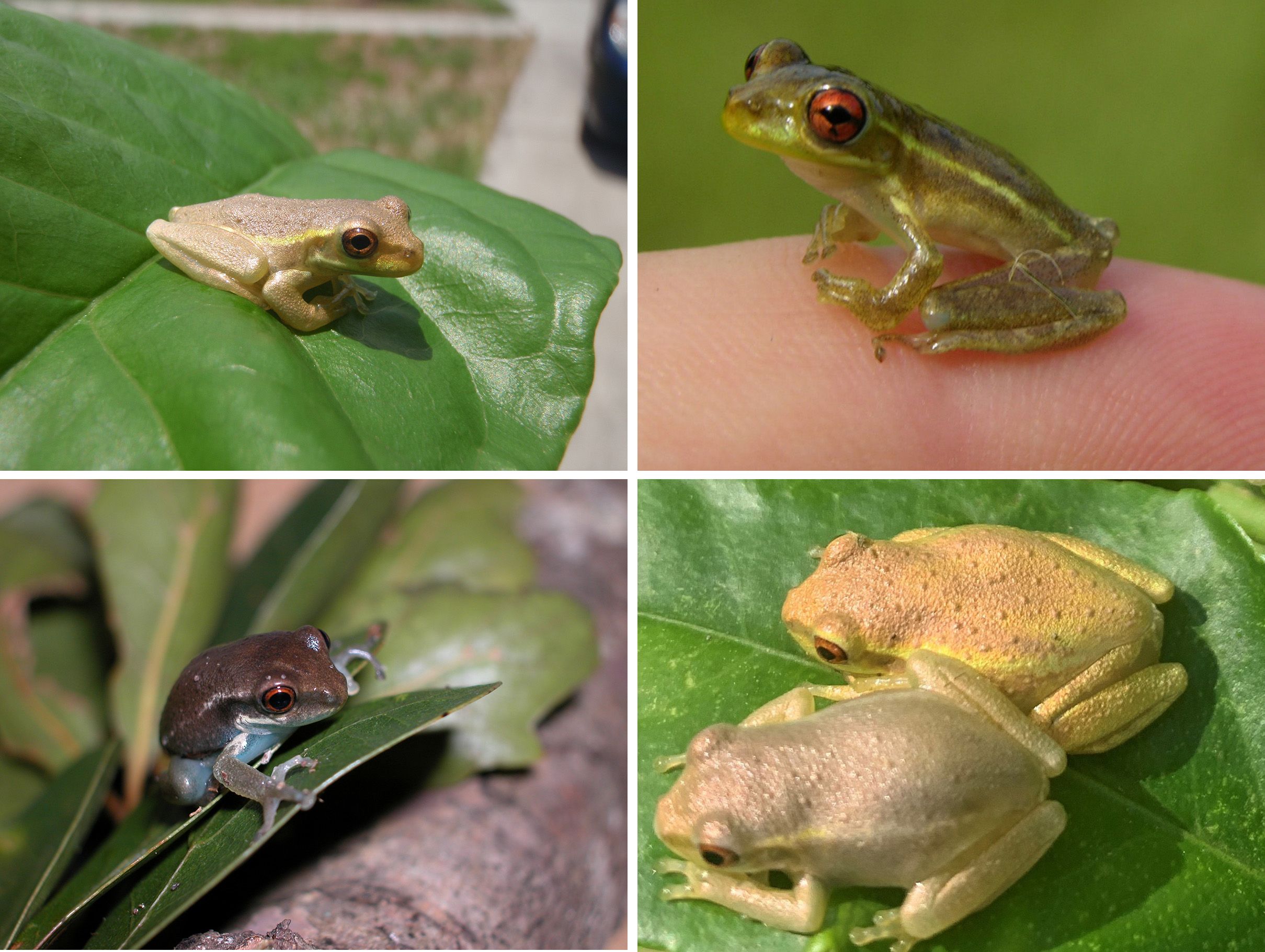
Credit: First three images by Steve A. Johnson, UF/IFAS; bottom right image by Melissa Reynolds
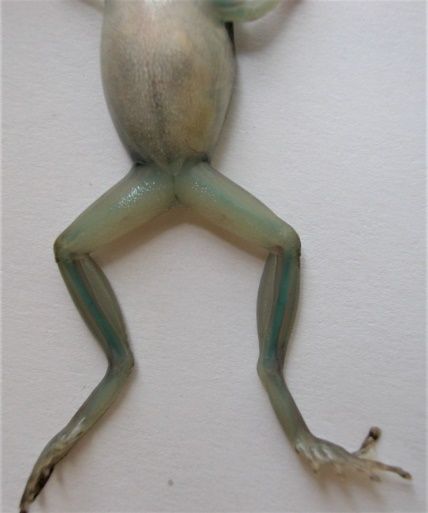
Credit: Steve A. Johnson, UF/IFAS
Tadpoles of many of Florida’s frogs are inherently challenging to identify, even for experts. However, the location of a tadpole’s eyes on its head can assist with identifying the general type of frog. For example, the eyes of toad tadpoles are located well on top of the head, whereas the eyes of treefrog tadpoles (including Cuban treefrogs) are more lateral and on the side of the head. The eyes make up the silhouette of a treefrog tadpole when viewed from above. Tadpole size can also help with identification. The tadpoles of bullfrogs and other aquatic frogs can grow to well over 2 inches long including the tail. Cuban treefrog tadpoles attain a maximum length of approximately 1.25 inches. Cuban treefrog tadpoles have a dark brown body, and their tail is mottled with dark blotches and spots. (Tadpole color can change depending on the water color and clarity, so tadpole color alone is not a good feature for identification.) The upper part of the tail muscle is dark, and the lower part is white or cream colored (Figure 7). As described below, Cuban treefrogs often breed in artificial water bodies near human development, so the location where tadpoles are found can assist with identification. Tadpoles fitting the above description and found in small, artificial bodies of water within the range of the Cuban treefrog shown above in Figure 2 are likely Cuban treefrogs.
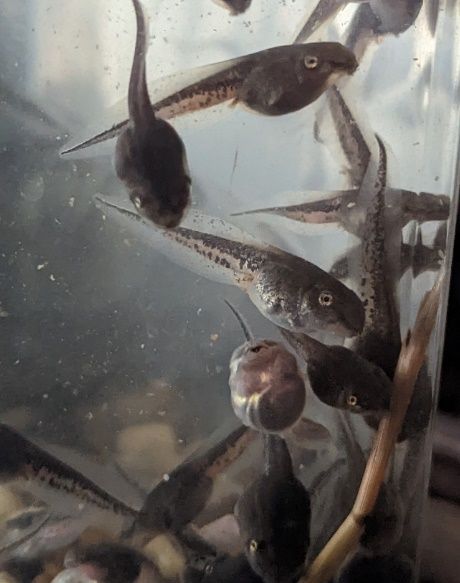
Credit: Maurl Foxx
Some frogs lay eggs in round masses and some deposit strings of eggs, but Cuban Treefrogs lay their eggs as a film on the water’s surface (Figure 8). The eggs look like small, floating black spots and are evenly spaced. They may be in small groups or a large raft, depending on how much they have been disturbed. Cuban treefrogs lay their eggs in small water bodies and often in artificial containers such as buckets, bird baths, ornamental ponds, livestock water troughs, and swimming pools.
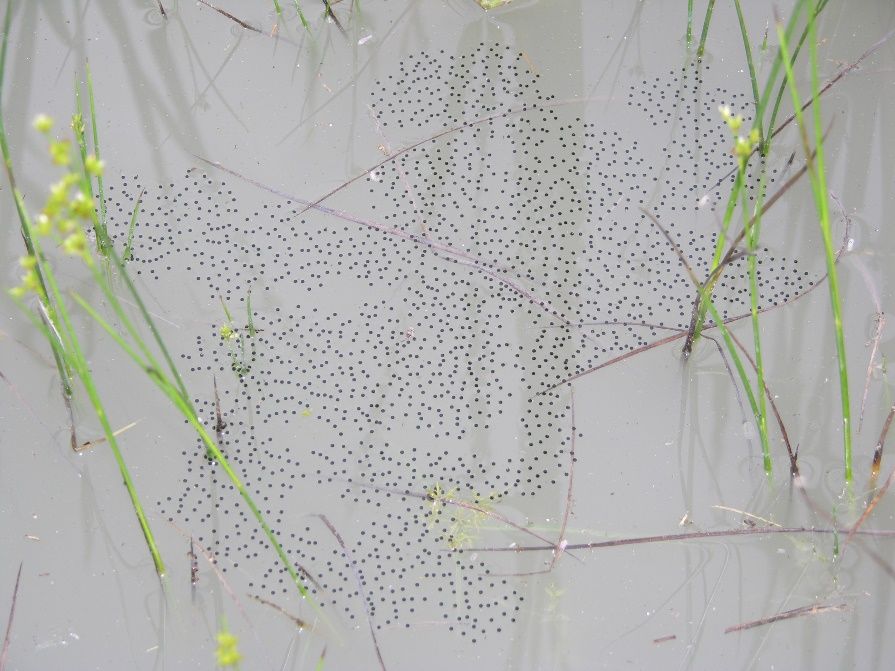
Credit: Steve A. Johnson, UF/IFAS
Cuban Treefrog Biology
Habitats and Distribution
Cuban treefrogs are found in a variety of natural and human-modified habitats in Florida. Natural habitats invaded by Cuban treefrogs include pine forests, hardwood hammocks, and swamps. They prefer densely forested woodlands and are not usually found in drier, open habitats such as scrub and sandhills (McGarrity and Johnson 2010). Scientific experiments have shown that Cuban treefrogs are more prone to dehydration than some native treefrogs, which may explain their affinity for moist areas (Roznik, Rodriguez-Barbosa, and Johnson 2018). Although they invade some natural habitats, Cuban treefrogs are most common in areas near human development, such as suburban neighborhoods. In urban and suburban settings, they are most commonly found on and around homes and buildings, and in gardens and landscape plants. They also occur in agricultural settings, orange groves, and plant nurseries (Meshaka 2001). They range throughout Florida's Peninsula (Figure 2) and, as of early 2023 had established in several areas of the Florida Panhandle in proximity to human development. Their range expansion is facilitated by the activities of people. Cuban treefrogs are transported to new areas as stowaways on cars, trucks, campers, and boats as well as in ornamental plants and trees that are shipped from southern Florida (S.A. Johnson, unpublished data).
Like Florida’s native treefrogs, Cuban treefrogs are excellent climbers and will climb high into trees where they sleep during the day sheltered in cavities or between leaves (Meshaka 1996). They also occur closer to the ground in small trees and shrubs. They have even been found buried several inches deep in the soil. In suburban settings, they hide in just about any crevice or protected area on and around homes and buildings. Like our native treefrogs, Cuban treefrogs are most active at night when the humidity is high (McGarrity and Johnson 2010).
Diet and Predators
Invasive Cuban treefrogs in Florida eat a wide variety of food items, including snails, millipedes, spiders, and a vast array of insects (Glorioso et al. 2012; S.A. Johnson, unpublished data). They are predators of several of Florida's native frogs and are cannibalistic (Wyatt and Forys 2004). They will also eat lizards and even small snakes. Several species of native Florida snakes will eat Cuban treefrogs, including rat snakes, black racers, pygmy rattlesnakes, and gartersnakes. Owls, crows, and wading birds have also been seen feeding on Cuban treefrogs.
Breeding
Cuban treefrogs breed predominately in the spring and summer, but in southern Florida, they can breed year-round (Meshaka 2001). Reproduction is largely stimulated by rainfall, especially warm summer rains such as those associated with tropical weather systems and thunderstorms. The number of eggs deposited by a female is related to her size—larger females lay more eggs. A large female may lay several thousand eggs in a season (Meshaka 2001). Cuban treefrogs are not picky about their breeding sites, as long as sites are free of predatory fish, such as bass and bream. Acceptable breeding sites include isolated wetlands, ditches, decorative ponds, and even swimming pools. Cuban treefrogs can breed in surprisingly small amounts of water. An old ice chest, a child's wading pool, or even a 5-gallon bucket half full of rainwater are suitable nurseries for Cuban treefrog tadpoles.
Calls
Male Cuban treefrogs have a distinct raspy call that sounds like a squeaking door. Visit the websites listed at the end of this publication to find links to recordings of Cuban treefrog calls. In addition to their breeding calls, individual males will call from daytime retreat sites to advertise their presence. This "rain call," as it is sometimes called, can be triggered by light rainfall during the day.
Invasive Cuban Treefrogs and Their Impacts in Florida
As defined earlier, an invasive species may harm the ecology, economy, or quality of human life where its introduced. Cuban treefrogs meet the definition of an invasive species because they were introduced to Florida accidentally by people and are causing harm to Florida's natural ecosystems and the quality of life of Floridians. They are also causing negative economic impacts in some places.
Ecological Harm
Cuban treefrogs are having negative impacts on Florida's environment. In both natural and urbanized settings, Cuban treefrogs are known predators of Florida's native treefrogs (Figure 9) and appear to be responsible for declines of some native treefrog species, especially in urbanized areas. Native squirrel treefrogs appear particularly susceptible, likely because their small size makes them highly vulnerable to predation by the larger Cuban treefrogs (Campbell, Campbell, and Johnson 2010). And Cuban treefrog tadpoles will even prey upon the tadpoles of squirrel treefrogs in some situations (Smith 2005b). Researchers found that survivorship of native squirrel treefrog tadpoles declined significantly in the presence of Cuban treefrog tadpoles (Knight, Parris, and Gutzke 2009).
In addition to predation, numerous other negative impacts of Cuban treefrogs on native wildlife have been discovered or are suspected. For example, lab experiments have shown that Cuban treefrog tadpoles are superior competitors with at least two species of native frog tadpoles (Smith 2005a). Tadpoles of the invasive Cuban treefrog inhibited the growth and development of native southern toad and green treefrog tadpoles. Although numerous species of native snakes have been documented to eat Cuban treefrogs, the frog’s toxic skin secretions render them less nutritious than native frogs. Eastern gartersnakes fed a diet of Cuban treefrogs gained half the weight as those fed native green treefrogs (Goetz et al. 2018). Scientists studying Cuban treefrogs in the Tampa area found they are likely the source of several nonnative parasites that now infect native treefrogs (Ortega et al. 2015). Cuban treefrogs also harbor diseases of conservation concern for amphibians and are likely vectors for spread of these diseases in the United States (Galt et al. 2021).
Many homeowners in Florida report that Cuban treefrogs appear to have replaced native treefrogs as the dominant frog found around their homes, especially in southern Florida. These same people say that they no longer see native species, such as squirrel treefrogs or green treefrogs, but only Cuban treefrogs. As scientists continue to conduct research on the ecological impacts of Cuban treefrogs, we will develop a better understanding of the ultimate effects that this invasive frog is having on Florida's natural environment.

Credit: Nancy Bennett
Human Quality-of-Life Impacts
Cuban treefrogs thrive in human-modified landscapes and are the most commonly encountered frog around suburban homes in much of peninsular Florida. As a result, they are having impacts on the quality of life of Floridians. Cuban treefrogs seek shelter during the day in tight, enclosed spaces, such as behind storm shutters and vinyl siding. Homes and buildings provide many of these shelters as well as abundant sources of food in the form of insects attracted to lights. Because of the combination of abundant places to hide, consistent food sources, and suitable breeding sites provided by human-dominated landscapes, Cuban treefrog populations can become quite dense, and conflicts between people and the frogs arise.
Cuban treefrogs are "sit-and-wait" predators. On warm nights it is common to encounter them hanging on walls and windows near lighted areas as they sit and wait for insects attracted to the lights. As they feed, they defecate on the windows and walls, and their fecal deposits can become unsightly over time, especially if there are a lot of frogs in the area. Furthermore, when a person enters or exits their home at night, Cuban treefrogs that are waiting for an insect meal may be startled and will occasionally jump onto people or into their homes through open doors. This can be a scary experience for a person who is afraid of frogs. Florida's native treefrogs rarely enter homes and buildings and do not cause the problems attributed to Cuban treefrogs.
Cuban treefrogs enter homes in a variety of ways. They may jump through open doors or windows, be brought into a house inadvertently on an ornamental plant, or get into a home's plumbing system through vent pipes on the roof. When Cuban treefrogs gain access through vent pipes of a home plumbing system, they usually end up in a bathroom. There are numerous instances where unsuspecting people have opened the lid to their toilet only to find a bug-eyed Cuban treefrog staring up at them (Figure 10). Cuban treefrogs have also been responsible for clogging sink drains.

Credit: Des McAdam
Like most frogs, male Cuban treefrogs call to attract mates. When Cuban treefrogs are concentrated in an area for breeding, their calls may be annoying, especially following heavy rains. Males may call anytime of the night, but peak calling activity is often in the hours before dawn. As a result, loud choruses of Cuban treefrogs can disrupt sleep for people who live near breeding sites.
Cuban treefrogs may also be a nuisance to wildlife enthusiasts. Because Cuban treefrogs prefer enclosed hiding spaces, they readily enter nest boxes erected for birds. Birds may be dissuaded from using nest boxes when they are invaded by Cuban treefrogs (Figure 11), but research is needed to study how the presence of the invasive frogs affects bird use of the boxes.
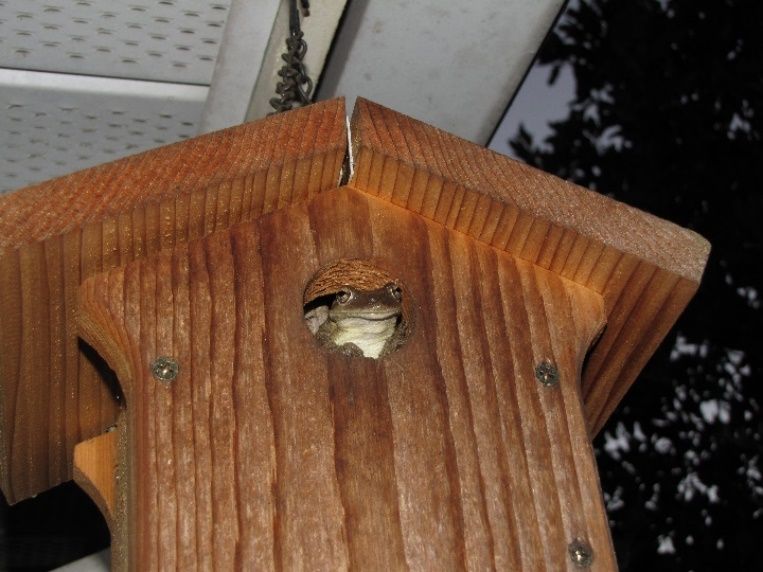
Credit: Steve A. Johnson, UF/IFAS
When handled or harassed, Cuban treefrogs secrete a sticky toxin as defense against their would-be predator. Cuban treefrog secretions are extremely irritating to the mucous membranes of mammals, especially humans. The secretions cause a burning and itching sensation of the eyes and nose that can last for more than an hour. The best way to avoid the frogs’ secretions is to not handle them with bare hands—use rubber gloves or other hand protection when capturing Cuban treefrogs. Thorough handwashing is also advised after handling Cuban treefrogs.
Although they are not nearly as toxic as cane/bufo toads (see https://edis.ifas.ufl.edu/publication/UW432), the secretions of Cuban treefrogs can cause discomfort to dogs and cats that attack and bite the frogs. The Cuban treefrog’s toxin irritates the mucous membranes of a pet’s mouth causing excessive salivation. Though they are not lethal to pets, there are reports of seizures in pets that have tangled with these noxious frogs, so dogs and cats should be kept away from Cuban treefrogs.
In 2022, scientists at the University of Florida’s College of Veterinary Medicine discovered a rat lungworm parasite (Angiostrongylus cantonensis) in a Cuban treefrog from Volusia County, FL (Chase et al. 2022). This parasite is known to infect humans, but for this to happen, a person must eat an infected host animal such as a frog. People cannot be infected by simply handling an infected host. However, a pet dog or cat that eats an infected frog could become infected with the rat lungworm parasite, but presently this should not be a concern for pet owners in Florida.
Economic Impacts
Unlike many invasive insect pests and invasive plants, Cuban treefrogs do not currently appear to be having any large-scale negative effects on Florida's economy. Nonetheless, they are known to invade transformer boxes and electrical switches and occasionally cause short-circuits. This increases maintenance costs for electrical utility companies, and power to some customers in central Florida has been interrupted as a result of short-circuits caused by Cuban treefrogs. They may also invade electric pump housings and AC compressor units around residential homes, potentially causing damage.
What You Can Do
There are several things Floridians can do to help manage invasive Cuban treefrogs and to help scientists track their spread in the state and elsewhere. You can help advance knowledge about the geographic distribution of this invasive species by reporting your sightings (see below) of Cuban treefrogs. As Cuban treefrogs continue to expand their range, precise tracking of their status and distribution is imperative for decision-making and resource management. In addition to helping track the expansion of their range, you can also help manage this invasive species in and around your yard. Because Cuban treefrogs eat native frogs and other wildlife, it is important that we take action to manage them and reduce their negative impacts on our native species. Managing Cuban treefrogs will also help reduce their negative impacts on the quality of life of Floridians. Benefits will be greatest in the immediate area around where the frogs are managed (i.e., your yard).
Manage Cuban Treefrogs around Your Home
There are numerous steps you can take to manage Cuban treefrogs around your home to reduce conflicts with this invasive frog and help Florida’s native treefrogs and other wildlife. An integrated approach that includes removing adult and juvenile Cuban treefrogs, eliminating artificial breeding sites, and making your yard less attractive to these invasive frogs is the most effective strategy. Successfully managing Cuban treefrogs requires ongoing effort and persistence for long-term success. Scientific research found increased survival and recovery of native treefrogs when Cuban treefrogs are removed (Rice et al. 2011), so know your efforts will not be in vain and that you are being an advocate for Florida’s native frogs by removing their invasive predator. There are not any university or government programs for removing Cuban treefrogs, so it’s up to each homeowner to manage Cuban treefrogs on their property.
Because of the negative effects of invasive Cuban treefrogs on Florida's native species, as well as the problems they cause for people, Cuban treefrogs should be captured and humanely euthanized. However, before you euthanize a Cuban treefrog, be sure that you are positive about its identification. Please visit the UF/IFAS Wildlife website at https://ufwildlife.ifas.ufl.edu/cuban_treefrog_inFL.shtml for identification tips and to see digital images of Cuban treefrogs and native species. At this site, you will also find lots of helpful information about catching, identifying, and reporting Cuban treefrogs.
To humanely euthanize a Cuban treefrog, you must first capture it; there are several effective methods for doing this. The first is to simply grab the frog from a window, wall, or other perch site. Be sure to use a plastic grocery bag or similar plastic sack as a glove to capture the frog. Approach quickly and decisively, and with a continuous, swift movement firmly grab the frog (Figure 12). Maintain a firm grip on the frog and then simply tie the bag shut to contain the frog.
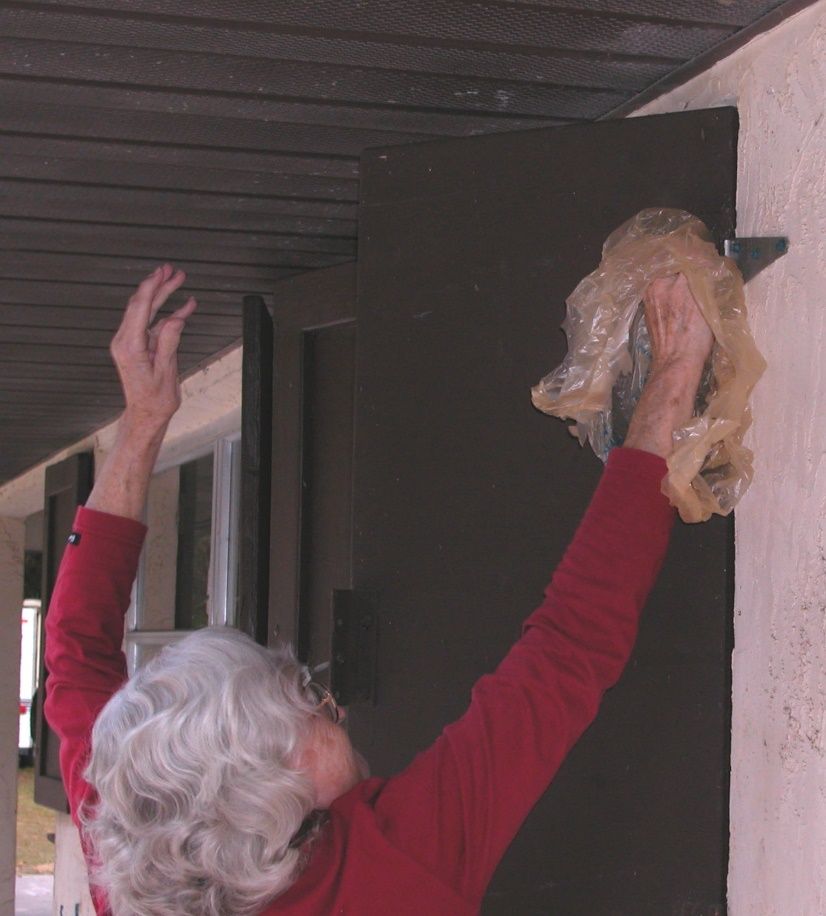
Credit: Steve A. Johnson, UF/IFAS
Another way to capture Cuban treefrogs is to attract the frogs to hiding places where they can be easily captured and removed. To do this, place short sections of PVC pipe in the ground around your home and garden (Figure 13). Cut 10-foot sections of 1.5-inch-diameter PVC pipe (available at home improvement stores) into approximately three-foot-long sections and push them into the ground about 3–4 inches. (Be sure to purchase thin-walled PVC pipe, as its less expensive and easier to cut than thick-walled, schedule 40 pipe.) Place pipes in and near vegetation and in areas where you see or hear frogs. Cuban treefrogs may show up in the pipes in a few days, depending on the weather, time of year, and the density of frogs in your immediate area. In some instances, it may take several weeks for frogs to find the pipes, so be patient. If frogs don’t colonize a pipe within a month, move it to a new location. To remove a frog from a pipe, place a clear sandwich bag over the top end, pull the pipe from the ground, and insert a broom handle or other "plunger" device in the other end to scare the frog into the sandwich bag. Once it is in the bag, examine the frog to be sure that it is an invasive Cuban treefrog and not a native species. Euthanize Cuban treefrogs as described below and release native frogs back into the pipe. (PVC pipes provide great artificial habitats for native treefrogs and can help enhance the wildlife value of your garden.) For more details on using PVC pipes to attract treefrogs, see the UF/IFAS fact sheet on making treefrog houses (https://edis.ifas.ufl.edu/uw308).
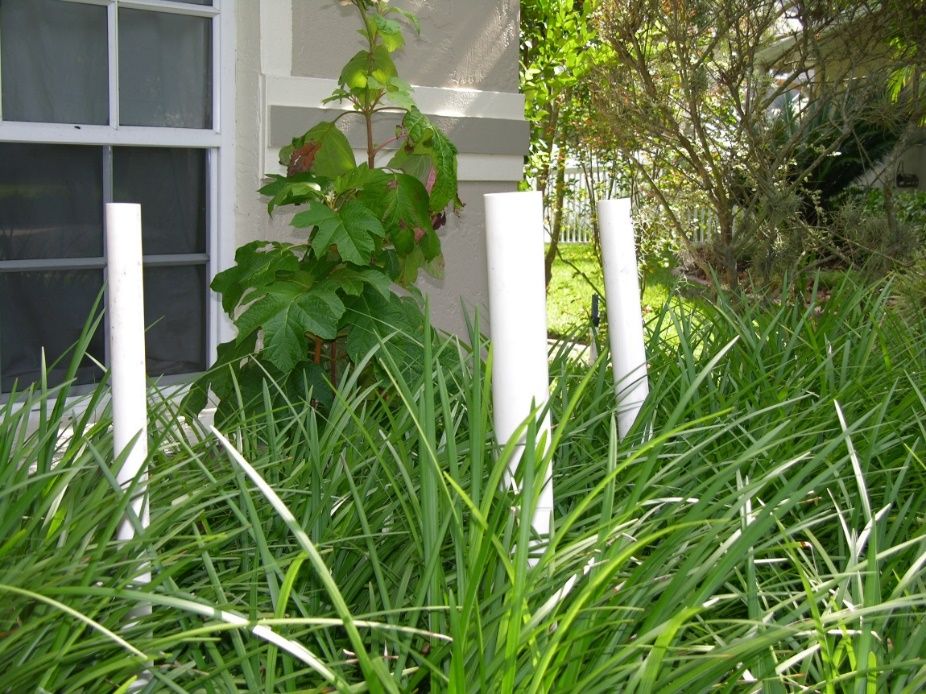
Credit: Steve A. Johnson, UF/IFAS
The easiest way to humanely euthanize a Cuban treefrog is to place the bagged frog in a refrigerator for 3–4 hours and then transfer it to a freezer for an additional 24 hours. The initial cool-down period in the fridge acts as a physical anesthetic to numb the frog so it does not feel any pain when it freezes. Alternatively, you can firmly hold a recently captured Cuban treefrog and apply a benzocaine-containing ointment to the frog's back to chemically anesthetize it before placing it into a freezer to ensure death. To do this, apply a 1-inch strip of benzocaine ointment (Orajel is one popular brand) to the frog's back, rub the ointment around so it covers the back, and then after the frog has ceased to move put it in a sealed bag and place in a freezer for 24 hours. After freezing, simply remove the bagged frog from the freezer and dispose of it in the trash. Do not use bug spray, suntan lotion, insecticide, bleach spray, or other household chemicals to euthanize Cuban treefrogs, and never place a live, bagged frog into the trash! Remember to wash your hands thoroughly after handling a Cuban treefrog to avoid any adverse reaction to its noxious skin secretions.
You can also reduce the negative impacts of Cuban treefrogs by eliminating eggs, tadpoles, and potential breeding sites. Monitor ornamental ponds for Cuban treefrog egg masses (Figure 8) during the spring and summer, especially after heavy rains. Be sure to check for eggs on mornings after rain so the eggs do not have time to hatch. Use a small-mesh aquarium net to scoop out Cuban treefrog eggs floating on the surface of the pond and simply discard them on the ground. You should also remove Cuban treefrog tadpoles from ornamental fishponds and euthanize them by cooling and then placing in a freezer as described earlier. For Cuban treefrog tadpoles found in buckets, bird baths and other artificial structures, simply dump the water and tadpoles onto the ground. This mimics the natural process of a breeding pond drying out before the tadpoles can metamorphose into frogs. It’s common for people to think they are doing a good thing by “saving” tadpoles found in artificial sources of water around their home. But in many instances, they are just contributing to the Cuban treefrog population. Properly maintain swimming pools so they are not attractive to Cuban treefrogs and dump out stagnant water that accumulates in various objects around your yard (e.g., ice coolers, buckets, etc.). This will also help eliminate breeding sites for mosquitoes.
If you live in the range of the Cuban treefrog or visit areas where they are established, you can do your part to not transport them elsewhere. Cuban treefrogs get moved around inadvertently while hidden in cars, campers, and boats. While it’s not practical to search every nook and cranny of a vehicle or boat, it’s a good idea to search the easily accessible places where a frog might hide. For example, check for Cuban treefrogs under the bow and stern of canoes and in the cockpit and storage areas of kayaks, and roll open camper awnings to search for hidden frogs before departing.
As noted earlier, Cuban treefrogs may gain access to a house through the vent pipes located on the roof. There will usually be a pipe for each bathroom and the kitchen. Covering these pipes will prevent Cuban treefrogs from gaining access to your plumbing system and ending up in a toilet. Pipe covers can be purchased at home-improvement stores, or you can make your own cover out of hardware cloth and cable ties as seen in Figure 14. Another way to make your house less attractive to Cuban treefrogs is by turning off unnecessary lights at night and replacing outdoor bulbs with yellow “bug lights” so your home is less attractive to insects that the frogs eat.
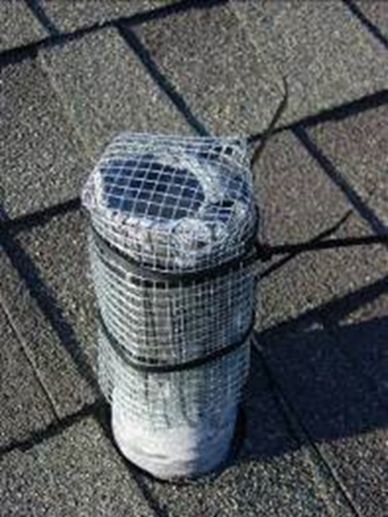
Credit: Steve A. Johnson, UF/IFAS
Report Sightings of Cuban Treefrogs
It is important to document the locations of Cuban treefrogs in Florida, especially in the Panhandle, and elsewhere in the United States and Canada. If you see a Cuban treefrog, or suspect you have seen one, outside of peninsular Florida, please email Dr. Steve A. Johnson at tadpole@ufl.edu. Include your name, date you saw the frog, where you saw it (state, county, city, street address), and attach a digital image so Dr. Johnson can positively identify the frog. It is also important to report Cuban treefrog sightings from peninsular Florida (and elsewhere) at EDDMapS, the online mapping system for invasive species in the United States. Visit https://www.eddmaps.org/ and click the "Report Sightings" tab. Thank you for being a citizen scientist and doing your part to manage invasive Cuban Treefrogs on your property!
Scientific References
Barbour, T. 1931. “Another Introduced Frog in North America.” Copeia 1931:140. https://doi.org/10.2307/1437340
Campbell, K. R., T. S. Campbell, and S. A. Johnson. 2010. “The Use of PVC Pipe Refugia to Evaluate the Spatial and Temporal Distributions of Native and Introduced Treefrogs.” Florida Scientist 73:78–88.
Chase, E. C., R. J. Ossiboff, T. M. Farrell, A. L. Childress, K. Lykins, S. A. Johnson, N. Thompson, and H. D. S. Walden. 2022. “Rat lungworm (Angiostrongylus cantonensis) in the Invasive Cuban Treefrog (Osteopilus septentrionalis) in Central Florida, USA.” Journal of Wildlife Diseases 58:454–456. https://doi.org/10.7589/JWD-D-21-00140
Galt, N., M. S. Atkinson, B. M. Glorioso, J. H. Waddle, M. Litton, and A. E. Savage. 2021. “Widespread Ranavirus and Perkinsea Infections in Cuban Treefrogs (Osteopilus septentrionalis) Invading New Orleans, USA.” Herpetological Conservation and Biology 16:17–29.
Glorioso, B. M., J. H. Waddle, M. E. Crockett, K. G. Rice, and H. F. Percival. 2012. “Diet of the Invasive Cuban Treefrog (Osteopilus septentrionalis) in Pine Rockland and Mangrove Habitats in South Florida.” Caribbean Journal of Science 46:346–355. https://doi.org/10.18475/cjos.v46i2.a25
Glorioso, B. M., J. H. Waddle, L. J. Muse, N. D. Jennings, M. Litton, H. Hamilton, S. Gergen, and D. Heckard. 2018. “Establishment of the Exotic Invasive Cuban Treefrog in Louisiana.” Biological Invasions 20:2707–2713. https://doi.org/10.1007/s10530-018-1732-1
Goetz, S. M., C. Guyer, S. M. Boback, and C. M. Romagosa. 2018. “Toxic, Invasive Treefrog Creates Evolutionary Trap for Native Gartersnakes.” Biological Invasions 20:519–531. https://doi.org/10.1007/s10530-017-1554-6
Henderson, R. W., and R. Powell. 2009. Natural History of West Indian Reptiles and Amphibians. University of Florida Press, Gainesville, FL. 495 pp.
Iannone, B. V, III, S. Carnevale, M. B. Main, J. E. Hill, J. B. McConnell, S. A. Johnson, S. F. Enloe, M. Andreu, E. C. Bell, J. P. Cuda, and S. M. Baker. 2020. “Invasive Species Terminology: Standardizing for Stakeholder Education.” Journal of Extension 58: Published digitally (https://joe.org/joe/2020june/a3.php)
Jarboe, C., J. E. Colbert, Y. Moore, D. Steen, and S. A. Johnson. 2019. “Osteopilus septentrionalis (Cuban Treefrog) Geographic Distribution.” Herpetological Review 50:97–98.
Knight, C. M., M. J. Parris, and W. H. N. Gutzke. 2009. “Influence of Priority Effects and Pond Location on Invaded Larval Amphibian Communities.” Biological Invasions 11:1033–1033. https://doi.org/10.1007/s10530-008-9314-2
Krysko, K. L., K. M. Enge, and P. E. Moler. 2019. Amphibians and Reptiles of Florida. University of Florida Press, Gainesville, FL, 706 pp.
Lever, C. 2003. Naturalized Reptiles and Amphibians of the World. Oxford University Press, Oxford, UK. 318 pp.
McGarrity, M. E., and S. A. Johnson. 2009. “Geographic Trend in Sexual Size Dimorphism and Body Size of Osteopilus septentrionalis (Cuban Treefrog): Implications for Invasion of the Southeastern United States.” Biological Invasions 11:1411–1420. https://doi.org/10.1007/s10530-008-9349-4
McGarrity, M. E., and S. A. Johnson. 2010. “A Radio Telemetry Study of Invasive Cuban Treefrogs.” Florida Scientist 73:225–235.
Meshaka, W. E. 1996. “Retreat Use by the Cuban Treefrog (Osteopilus septentrionalis): Implications for Successful Colonization in Florida.” Journal of Herpetology 30:445–447. https://doi.org/10.2307/1565191
Meshaka, W. E. 2001. The Cuban Treefrog in Florida: Life History of a Successful Colonizing Species. University of Florida Press, Gainesville, FL, 224 pp.
Ortega, N., W. Price, T. Campbell, and J. Rohr. 2015. “Acquired and Introduced Macroparasites of the Invasive Cuban Treefrog (Osteopilus septentrionalis).” International Journal for Parasitology: Parasites and Wildlife 4:379–384. https://doi.org/10.1016/j.ijppaw.2015.10.002
Rice, K. G., J. H. Waddle, M. W. Miller, M. E. Crockett, F. J. Mazzotti, and H. F. Percival. 2011. “Recovery of Native Treefrogs after Removal of Nonindigenous Cuban Treefrogs, Osteopilus septentrionalis.” Herpetologica 67:105–117. https://doi.org/10.1655/HERPETOLOGICA-D-10-00020.1
Rodder, D., and F. Weinsheimer. 2009. “Will future anthropogenic climate change increase the potential distribution of the alien invasive Cuban treefrog (Anura: Hylidae)?” Journal of Natural History 43:1207–1271. https://doi.org/10.1080/00222930902783752
Roznik, E. A., C. A. Rodriguez-Barbosa, and S. A. Johnson. 2018. “Hydric Balance and Locomotor Performance of Native and Invasive Frogs.” Frontiers in Ecology and Evolution 6: 159. https://doi.org/10.3389/fevo.2018.00159
Smith, K. G. 2005a. “Effects of Nonindigenous Tadpoles on Native Tadpoles in Florida: Evidence of Competition.” Biological Conservation 123:433–441. https://doi.org/10.1016/j.biocon.2005.01.005
Smith, K. G. 2005b. “An Exploratory Assessment of Cuban Treefrog (Osteopilus septentrionalis) Tadpoles as Predators of Native and Nonindigenous Tadpoles in Florida.” Amphibia-Reptilia 26:571–575. https://doi.org/10.1163/156853805774806313
Wyatt, J. L., and E. A. Forys. 2004. “Conservation Implications of Predation by Cuban Treefrogs (Osteopilus septentrionalis) on Native Hylids in Florida.” Southeastern Naturalist 3:695–700. https://doi.org/10.1656/1528-7092(2004)003[0695:CIOPBC]2.0.CO;2
Other Sources of Information
Carmichael, P., and W. Williams. 2004. Florida's Fabulous Reptiles and Amphibians. Tampa, FL: World Publications. 120 pp. ISBN: 0-911977-11-2. This is an excellent coffee-table book with wonderful pictures and accurate information.
Powell, R., R. Conant, and J. T. Collins. 2016. Peterson Field Guide to Reptiles and Amphibians of Eastern and Central North America. Boston, MA: Houghton Mifflin Company. 494 pp. ISBN: 978-0-544-12997-9. This is the standard field guide for many herpetologists (scientists that study amphibians and reptiles) and covers hundreds of species of amphibians and reptiles.
UF/IFAS Extension Florida Wildlife website http://www.wec.ufl.edu/extension/. Click the link to "Wildlife Information," and then find the link to the "Frogs & Toads of Florida" page. In addition to information on Florida's frogs, there are also links to many other useful, wildlife-related resources at the site.
UF/IFAS Department of Wildlife Ecology and Conservation website http://ufwildlife.ifas.ufl.edu/. Click the links for "Florida's Frogs" and "Invasive Cuban Treefrog.” This website contains images and identification tips for of all of Florida's frogs as well as access to recordings of the calls of the species, including the Cuban treefrog.
The Florida Museum of Natural History has a website where you can listen to the calls of many of Florida’s native frogs https://www.floridamuseum.ufl.edu/discover-herps/florida-frog-calls/. Scroll to the bottom of the page to listen to the call of a Cuban treefrog.